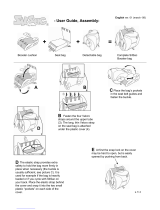
Introduction
8
Volvo Cars and the environment
Efficient emission control
Your Volvo is manufactured following the
concept Clean inside and out – a concept
that encompasses a clean interior environ-
ment as well as highly efficient emission con-
trol. In many cases the exhaust emissions are
well below the applicable standards.
Clean air in the passenger
compartment
A passenger compartment filter prevents
dust and pollen from entering the passenger
compartment via the air intake.
A sophisticated air quality system, IAQS
1
(Interior Air Quality System) ensures that the
incoming air is cleaner than the air in the traf-
fic outside.
The system consists of an electronic sensor
and a carbon filter. The incoming air is moni-
tored continuously and if there is an increase
in the level of certain unhealthy gases such
as carbon monoxide then the air intake is
closed. Such a situation may arise in heavy
traffic, queues and tunnels for example.
The entry of nitrous oxides, ground-level
ozone and hydrocarbons is prevented by the
carbon filter.
Textile standard
The interior of a Volvo is designed to be
pleasant and comfortable, even for people
with contact allergies and for asthma suffer-
ers. All of our upholstery and interior textiles
are tested with respect to certain unhealthy
substances and allergens as well as emis-
sions. This means that all textiles fulfil the
requirements in the Öko-Tex 100 standard
2
,
a major advance towards a healthier passen-
ger compartment environment.
Öko-Tex certification covers seatbelts, car-
pets and fabrics for example. The leather in
the upholstery undergoes chromium-free
tanning with natural plant substances and
fulfils the certification requirements.
Volvo workshops and the environment
Regular maintenance creates the conditions
for a long service life and low fuel consump-
tion for your car, and in this way you contrib-
ute to a cleaner environment. When Volvo’s
workshops are entrusted with the service
and maintenance of your car it becomes part
of our system. We make clear demands
regarding the way in which our workshops
are designed in order to prevent spills and
discharges into the environment. Our work-
shop staff have the knowledge and the tools
required to guarantee good environmental
care.
Reducing environmental impact
You can easily help reduce environmental
impact, for example, by driving economically,
by purchasing eco-labelled car care prod-
ucts and by servicing and maintaining the car
in accordance with the instructions in the
owner’s manual.
The following hints will help you to do your bit
for the environment (for further advice on
how you can reduce environmental impact
and drive economically, see page 116).
• Decrease fuel consumption by choosing
ECO tyre pressure, see page 160.
• A roof load and ski box
increase wind resistance,
leading to significantly
higher fuel consumption.
Remove them immedi-
ately after use.
• Remove unnecessary
items from the car - the greater the load
the higher the fuel consumption.
• Is your car equipped with an engine block
heater? If so, use it for a few hours before
starting from cold to reduce fuel con-
sumption and exhaust emissions.
• Drive gently and avoid braking too hard.
1
Option
2
More information on www.oekotex.com





















